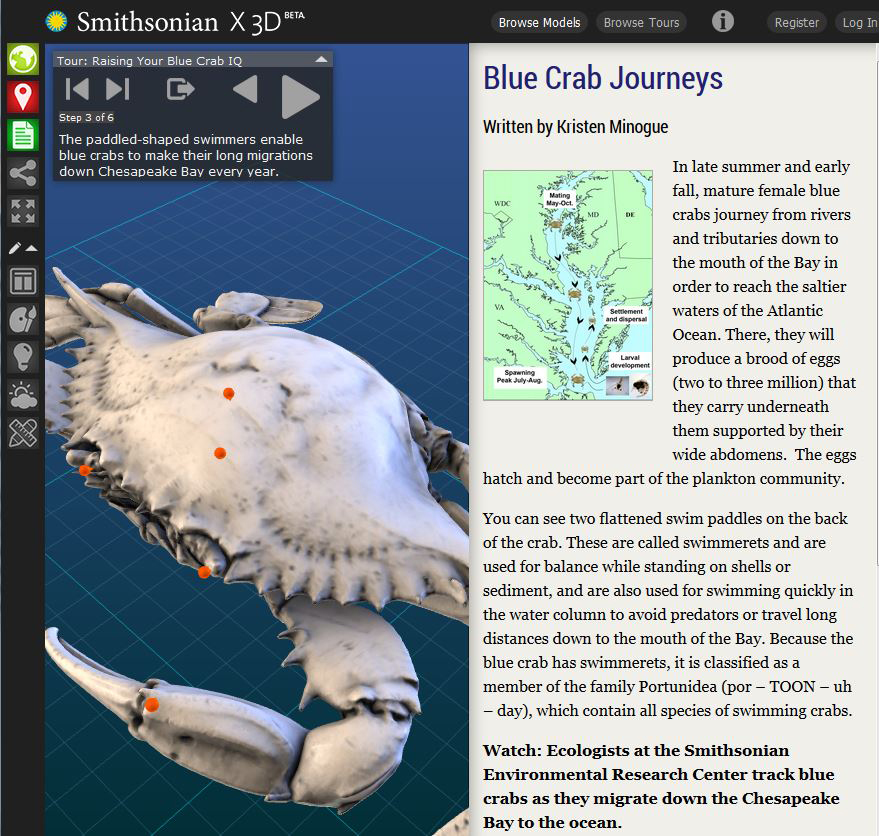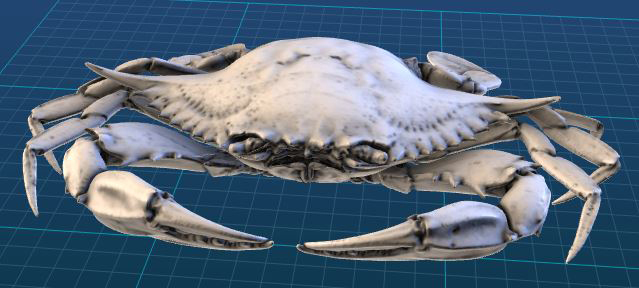by Karen McDonald
Can’t get to water to fish up a blue crab? Want to teach about blue crabs and Smithsonian research but can’t make it to SERC or the Chesapeake Bay? Landlocked, but you want students to measure a crab’s carapace and learn about its life cycle? SERC has the answer: a virtual blue crab.
The blue crab is just part of the new Smithsonian X3D—a revolutionary way for visitors to interact with Smithsonian collections and research. In November 2013 the Smithsonian launched the Smithsonian X3D (beta) program, which allows visitors to flip, rotate and zoom in on digitized 3D images of objects from across the Institution. Right now they can explore more than 20 objects, including Amelia Earhart’s flight suit, the Wright brothers’ plane and a life mask of Lincoln.
The Smithsonian’s Digitization Program Office led the effort by asking different museums and research centers to choose objects from their collections. Specialized computers did the heavy lifting of making them 3D. First, the computer scanned each object to create a “point cloud,” a collection of thousands of points that a computer can read to form a 3D image. Then the computer arranged the points into polygons and layered them to create the three dimensions of the object. The individual museums added the content, including guided tours of the objects, way-points or markers with information, the ability to cross-section the scan, and a measurement tool.

A stop on the guided tour of the blue crab, narrating how blue crabs migrate down Chesapeake Bay. (Smithsonian Institution)

Split-screen capture of the blue crab, showing how visitors can rotate and zoom in. (Smithsonian Institution)
“Once the website opened to the public we could easily feature the crab on our website to be included in the teacher resources section,” Haddon said. This could be especially helpful for students in urban areas without direct access to water or the Chesapeake Bay. But its applications go beyond the classroom. “The 3D model can be printed in 3D also [for those with a 3D printer]. I can see it being used for training parents who teach the Blue Crab station in the Estuary Chesapeake school field trip program. There are other opportunities for the 3D model to be used during special presentations to audiences around the state or the U.S.”
The Smithsonian is blazing a trail into the future of museum studies with three-dimensional interaction and imaging of its collections. This type of modeling is a way for people around the world to visit the Smithsonian, and its research centers, from their homes or classrooms. SERC’s contribution is just the beginning of a long-term relationship between science and technology that is being made available to the public.
Karen McDonald is a guest blogger, curriculum developer, science content editor and outdoor educator with over 13 years in informal science education. She has an MS in Biology and a BS in Environmental Science and Philosophy. Currently she works for the Smithsonian and contracts for Discovery Channel. Visit her home blog at The Infinite Spider.


